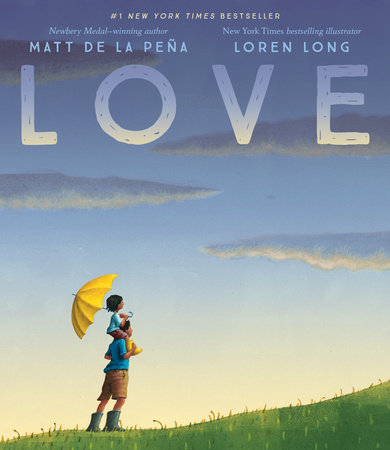Love Matt De La Pena Read Aloud Questions
Matt de la Peña's new picture book, Dear , with stunning artwork by Loren Long, is already a New York Times bestseller. The lyrical and moving meditation on dear has resonated with critics and with readers immature and former akin. Writing about dear is no easy undertaking and de la Peña has managed to do so in a way that not only stirs our hearts and minds, but also expands our very concept of this emotion. We chatted with Matt about how he set out to capture the feeling of love, the surprising journey that exploration took him on, and how he's plant love in all kinds of places.
To describe what dearest feels like is, in some ways, a pretty daunting task. How did you get started?
The whole thing began as a reaction to the electric current divisiveness we're seeing in our state. It seems like every time I turn on the TV, it'southward someone bashing someone else, or it's a bashing of the bashing. So I prepare out to write a comforting poem about love. And you're correct, I rapidly realized it was a pretty massive undertaking. Merely I eventually settled on this: I could only write my own perception of love. In the easily of any other person, it would be something else. We're all unique like that. We're all moved by different things. And it turned out my vision of dear included some darker elements.
You lot don't shy abroad from talking well-nigh the more complicated aspects of love in this book — dear lost, relationships broken, the demand to protect those nosotros love. Can you talk a bit more than about that decision to include the dark along with the light?
I tried to make the book purely uplifting, only I kept feeling like there was something missing. And then I had an epiphany about the arc of the poem. I wasn't following a single character, I was charting the evolution of dear in a child's life. In the beginning, love is handed to us (if we're fortunate enough to accept at least 1 caring parent or caregiver). This dearest is vital. But it's also incomplete. Somewhen a child must exist able to find love on his or her own. In the small things. This is when we learn to await outside of ourselves. So I wanted to have a sort of fall from grace. But when the child comes out on the other end of that fall, he or she is equipped for a more profound sense of dearest, which perchance culminates in a love of oneself. I approximate I but wanted to acknowledge that love isn't always light.
The book expands the notion of honey to include non only people but places and things — the smell of crashing waves, stars called-for in the sky, a slice of burned toast. Why were these of import elements of the story?
Humans are often consumed with human things. But love is everywhere, even in inanimate objects. We're so lucky to be alive. To know the sky, and the smell of the sea, and the power of a storm. I experience like it would be pretty narrow to stick to humans in a volume like this — fifty-fifty though information technology'southward ultimately a volume about humans.
Love feels like it's written as much for grown-ups every bit information technology is for kids. Was that intentional?
I wish I was smart plenty to consider my audition. I just write what is moving me the virtually at the fourth dimension, and I allow the publisher figure out what to do with information technology. I feel like Honey is written for me as much equally it'due south written for my three-twelvemonth-old girl. Just I have to tell you, there are some truly profound ideas being explored in pic books these days. I read my own when I visit loftier schools a lot of the time.
What was it like working with Loren Long? Were there any illustrations you were particularly stunned by?
Loren Long fabricated this poem a picture book. When I first saw his art, I understood how it could brand sense for children. My favorite part about the fine art is that he tried a brand-new technique. He sort of embraced the fact that dear isn't perfect. He took my poem and made it bigger and better than it ever could have been on its own. The spread that moves me the about is the large face, when the child turns inwards in her search for dear. We talked a lot about this moment. We knew the race nosotros chose was vital. Because the girl here is looking inward, but visually she's also staring directly at the reader, daring us to ignore her existence.

What'south i of the most unexpected places you've ever spotted love?
I remember this i moment from my childhood. I was ten. We were all at my Mexican grandma'south house for Female parent'due south Twenty-four hour period. One of my older cousins institute out something terrible had happened to her boyfriend at the time. She was inconsolable. She climbed under the glass coffee table in the living room and refused to come out. Information technology didn't affair what anyone said. Her mom couldn't talk her into coming out. Her dad. Finally my grandma climbed nether the table, too. And she held her. Never said a discussion. That was love, I call up. My old, arthritic grandmother climbing nether the tabular array to hold my crying cousin. And me watching.
Source: https://www.readbrightly.com/talking-love-matt-de-la-pena/

0 Response to "Love Matt De La Pena Read Aloud Questions"
Post a Comment